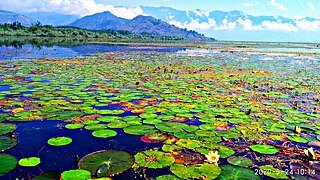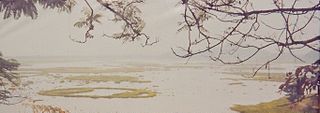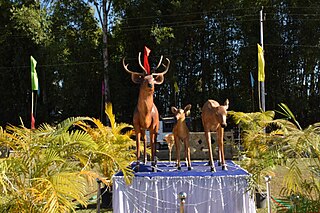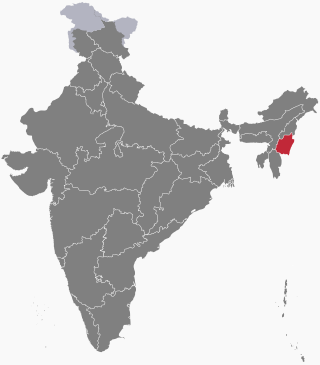
Manipur is a state in northeast India, with the city of Imphal as its capital. It is bounded by the Indian states of Nagaland to the north, Mizoram to the south and Assam to the west. It also borders two regions of Myanmar, Sagaing Region to the east and Chin State to the south. The state covers an area of 22,327 km2 (8,621 sq mi). The official and most widely spoken language is the Meitei language. Native to the Meitei people, it is also used as a lingua franca by smaller communities, who speak a variety of other Tibeto-Burman languages. Manipur has been at the crossroads of Asian economic and cultural exchange for more than 2,500 years. This exchange connects the Indian subcontinent and Central Asia to Southeast Asia, East Asia, Siberia, regions in the Arctic, Micronesia and Polynesia enabling migration of people, cultures and religions.

The Loktak Lake is a freshwater lake in Northeast India. It is the largest freshwater lake in South Asia. It is a pulsating lake, with a surface area varying from 250 sq km to 500 sq km during the rainy season with a typical area of 287 sq km. The lake is located at Moirang in Manipur state, India. The etymology of Loktak is Lok = "stream" and tak = "the end" in Meitei language. It is famous for the phumdi floating over it. The largest of all the phumdis covers an area of 40 km2 (15 sq mi) and is situated on the southeastern shore of the lake. Located on this phumdi, Keibul Lamjao National Park is the only floating national park in the world. The park is the last natural refuge of the endangered Sangai, Rucervus eldii eldii or Manipur brow-antlered deer, one of three subspecies of Eld's deer.

The Keibul Lamjao National Park is a national park in the Bishnupur district of the state of Manipur in Northeast India. It is 40 km2 (15.4 sq mi) in area, the only floating national park in the world, and an integral part of Loktak Lake. It is currently under the tentative lists of the UNESCO World Heritage Sites, under the title "Keibul Lamjao Conservation Area (KLCA)", additionally covering the buffer of Loktak Lake and Pumlen Pat.

Wular Lake, also known as Wolar in Kashmiri, is one of the largest fresh water lakes in South Asia. It is located near Bandipora town in the Bandipora district of Jammu and Kashmir, India. The lake basin was formed as a result of tectonic activity and is fed by the Jhelum River and stream Madhumati and Arin.

Thoubal district is one of the sixteen districts of Manipur state in northeastern India. This district is bounded by Senapati district on the north, Ukhrul and Chandel districts on the east, Churchandpur and Bishnupur districts on the south and Imphal West and Imphal East districts on the west. The district occupies an area of 324 km2. The population as of 2011 is 286,687. Thoubal town is the district headquarters. This district is known for Khongjom, where the last battle of the independence of Manipur was fought in April 1891 against the British army.

The Asan Barrage is a barrage in the Uttarakhand-Himachal Pradesh border region in Doon Valley,, northern India, situated at the confluence of the Eastern Yamuna Canal and the Asan River and about 11 km (7 mi) from Dakpathar, and 28 km. northwest of Dehradun in Uttarakhand. The barrage is 287.5m long and has water throughout the year which is fed from the river Asan and the discharge channel of the river Yamuna. Since 2020 it has been declared as Uttarakhand's first Ramsar site.
Mayang Imphal is a town and municipal council in Imphal West district in the Indian state of Manipur. Pin code of Mayang Imphal is 795132.

Damodar Valley Corporation (DVC) is a central power generating organisation which operates in the Damodar River area of West Bengal and Jharkhand states of India to handle the Damodar Valley Project, the first multipurpose river valley project of independent India. Indian Astrophysicist Meghnad Saha, the former chief architect of river planning in India, prepared the original plan for the Damodar Valley Project. It operates both thermal power stations and hydel power stations under the ownership of Ministry of Power, Government of India. DVC is headquartered in the Kolkata city of West Bengal, India.
The Jawahar Sagar Dam is the third dam in the series of Chambal Valley Projects on the Chambal River, located 29 km upstream of Kota city and 26 km downstream of Rana Pratap Sagar dam. It is a concrete gravity dam, 45 meters high and 393 meters long, generating 60 MW of power with an installed capacity of 3 units of 33 MW. Its construction was completed in 1972. The dam's gross storage capacity is 67.07 million cubic meters. The total catchment area of the dam is 27,195 km2, of which only 1,496 km2 are in Rajasthan. The free catchment area below Rana Pratap Sagar dam is 2,331 km2. The dam is located after the Gandhi Sagar Dam and Rana Pratap Sagar Dam, but before the Kota Barrage.
Leimakhong is a small town in the Kangpokpi district in Manipur, India .It is on Kangpokpi's border with the Imphal West district, approximately 30Km west of the Imphal city. It is on the bank of the Leimakhong River, a tributary of the Imphal River. The town is inhabited by Kuki, Nepali and Meitei communities. According to the 2011 census, the town had a population of 3544.

The Sharda River is the downstream of Kali River that originates in the northern Uttarakhand state of India in the Great Himalayas on the eastern slopes of Nanda Devi massif, at an elevation of 3,600 m (11,800 ft) in the Pithoragarh district. It then flows between the Nepal and India border. Descending, it enters the Indo-Gangetic Plain at Brahmadev Mandi in Nepal, where it expands above the Sharda Barrage. From that point onward, it is known as the Sharda River. The river proceeds southeastward into India through northern Uttar Pradesh before merging with the Ghaghara River southwest of Bahraich, covering a distance of approximately 300 miles.

Phumdi, also known as Phumthi or simply Phum, are a series of floating islands, exclusive to the Loktak Lake in Manipur state, in northeastern India. They cover a substantial part of the lake area and are heterogeneous masses of vegetation, soil and organic matter, in different stages of decay. The largest single mass of phumdi is in the southeastern part of the lake, covering an area of 40 km2 (15.4 sq mi). This mass constitutes the world’s largest floating park, named Keibul Lamjao National Park. The park was formed to preserve the endangered Eld's deer subspecies, called sangai in the Meitei language, indigenous to this area.

The Bhimgoda Barrage, also referred to as the Bhimgoda Weir or Bhimgoda Head Works, is a barrage on the Ganges River at Har ki Pauri near Haridwar in Haridwar district, Uttarakhand, India. Built as the headworks of the Upper Ganges Canal, an initial barrage was completed by 1854 and replaced twice; the final one completed in 1983. The primary purpose for the barrage is irrigation but it also serves to provide water for hydroelectric power production and control floods. The area behind the barrage is known as the Neel Dhara Bird Sanctuary and is a popular destination for various waterbirds and tourists.

Sangai Festival is an annual cultural festival organised by Manipur Tourism Department every year from 21 to 30 November. Even though many editions of this Festival has been celebrated over the past few years with the name of Tourism Festival, since 2010 this has been renamed as the Sangai Festival to stage the uniqueness of the shy and gentle brow-antlered deer popularly known as the Sangai, a regional name given to this rare species of deer. It is the state animal of Manipur. As this festival is being celebrated to promote Manipur as a world class tourism destination, it showcases the states contributions to art and culture, handloom, handicrafts, fine arts, indigenous sports, cuisine, music and adventure sports, as well as the natural environment. it is celebrated in different parts mainly in the valley areas of imphal. Many tourists come from all over the world and represent their craft making. Many people have also started to talk about the way Sangai festival is celebrated. They say that it should be celebrated only in one place with a proper arrangement and with big budget so that this festival grows more bigger and unique and spread all over the world.

Northeast India consists of eight states: Arunachal Pradesh, Assam, Manipur, Meghalaya, Mizoram, Nagaland, Sikkim and Tripura. Tourism in this area is based around the unique Himalayan landscape and culture distinct from the rest of India.

Pumlenpat is the second largest lake in Manipur after the Loktak Lake, situated about 68 kilometres (42 mi) south of Imphal and about 45 kilometres (28 mi) from Thoubal. Just as Loktak Lake, People situated around this lake depend on fishery products for their livelihood. The lake plays an important role in lives of the towns nearby. There are plenty of small islands on this lake; people started settling on these islands, and the lake is now on the verge of extinction due to human encroachment.
The Nambul River is a river in Manipur state, northeastern India, which flows through the heart of Imphal city.

The following outline is provided as an overview of and topical guide to Manipur:

Imphal Valley or Manipur Valley is located in the Indian state of Manipur and is an irregular almost oval shaped canyon that was formed as a result of the multiple small rivers that originate from neighbouring hill regions surrounding the valley and flow through it. The water in the Imphal valley is fetched from several rivers that flows via the valley, such as Imphal River, Iril River, Thoubal River, Khuga River and Sekmai river.
Mapithel Dam or Maphou Dam, officially known as the Thoubal Multipurpose Project, is a dam on the Thoubal river, in the Manipur state of India.
















